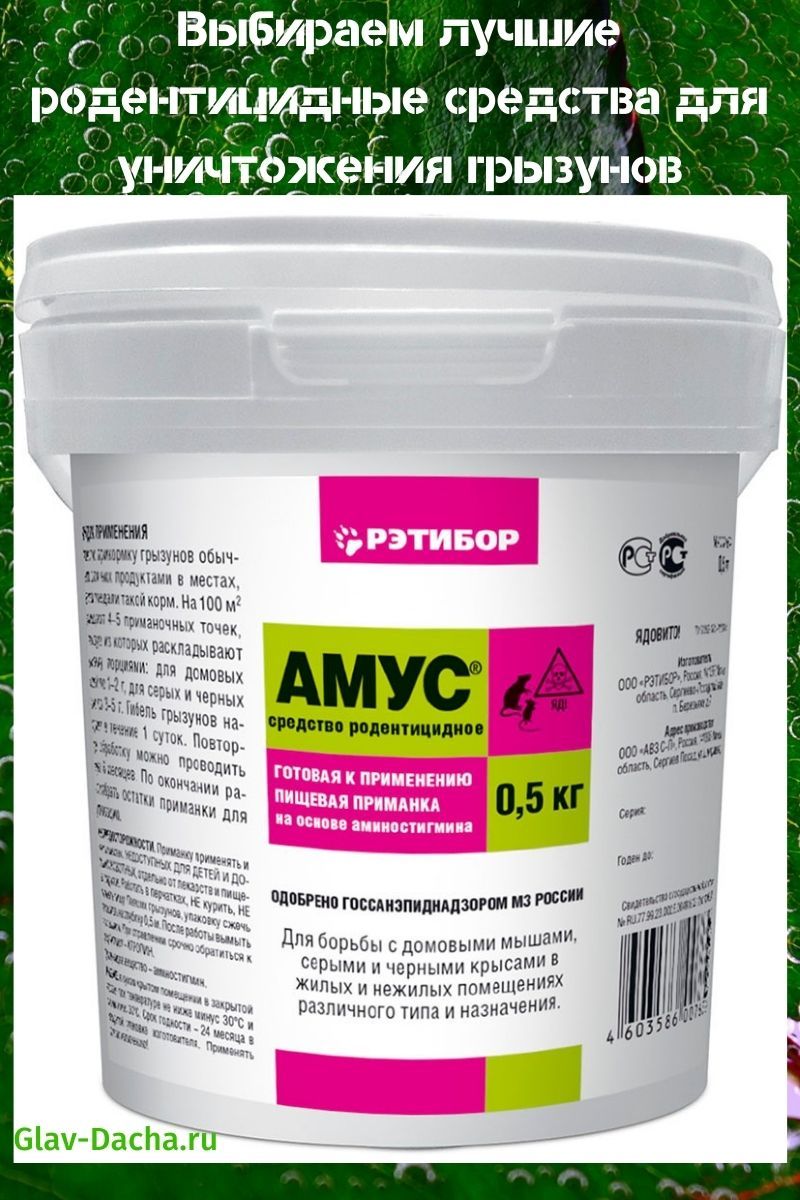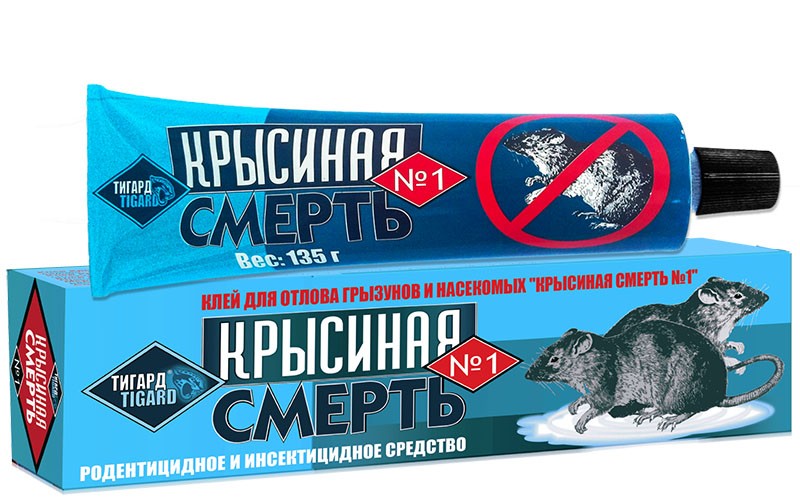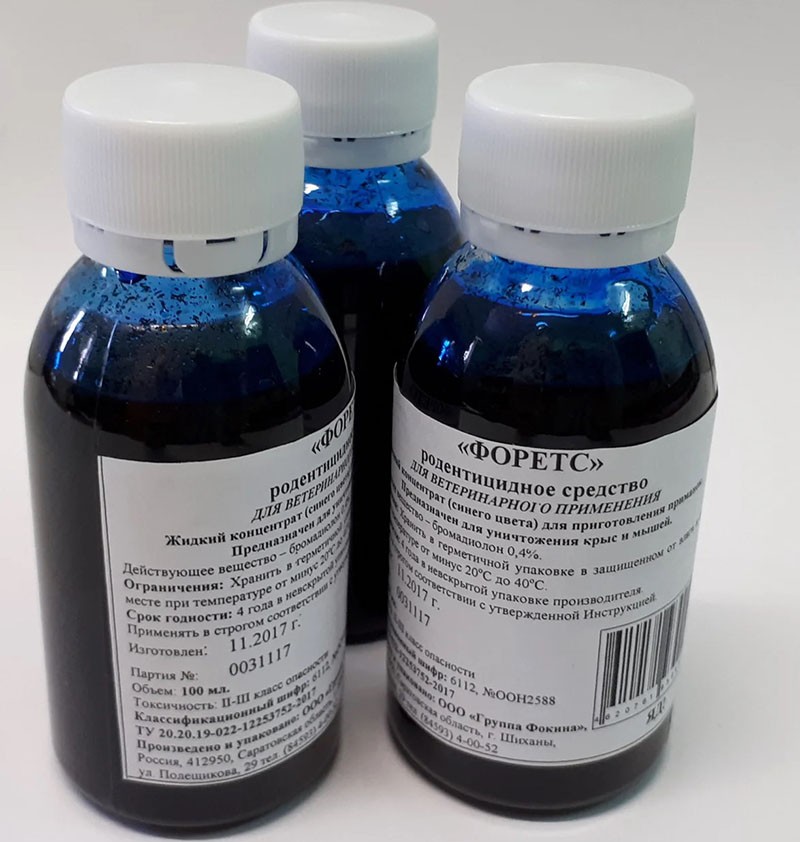Choosing the best rodenticides for rodent control
 In the fall, rodents leave the fields and move to gardens, sheds, one-story houses, high-rise buildings, storage of food and pet food. To exterminate rats, rodenticides are used - chemicals that cause massive poisoning of rodents. The article helps people living in a personal plot to find a suitable tool for fighting mice and rats.
In the fall, rodents leave the fields and move to gardens, sheds, one-story houses, high-rise buildings, storage of food and pet food. To exterminate rats, rodenticides are used - chemicals that cause massive poisoning of rodents. The article helps people living in a personal plot to find a suitable tool for fighting mice and rats.
What are rodenticides


According to the degree of toxicity, active substances are divided into 4 classes:
- Professionals work with dangerous poisons, amateurs - with relatively safe - III or IV class of toxicity.
- Gardeners and breeders use bait rodenticides, that is, those that enter the gastrointestinal tract.
- Amateurs use ready-made baits: they are relatively safe and convenient to use.
Non-professionals most often use slow-acting rodenticides, in which anticoagulants play the role of a poisonous substance. Less commonly, rapid-acting preparations containing thiourea are used.
Professional deratization in grain warehouses and elevators is carried out by a specially trained team using rodenticides, which release the poisonous gas Phosphine.
How rodenticides work

For the destruction of rodents, the following chemical compounds are used:
- Thiourea derivatives - Krysid. The chemical was named because of its selective toxic effect on rats. Death occurs due to respiratory arrest within 24 hours after eating the poisoned bait. Disadvantage - rodents notice signs of poisoning in a relative and stop eating the bait.

- Inorganic compounds: the use of Zinc Phosphide is of practical importance. The rodenticide is mixed with food that is attractive to rats and buried. The acidic environment of the stomach releases phosphorus, it combines with hydrogen ions, the poisonous gas Phosphine is formed, which has a suffocating effect. Zinc Phosphide is handled by specially trained personnel.

- Anticoagulant rodenticides are considered to be low toxicity drugs. For the production of baits, Coumarins, Brodifacum, Diphetialon, and other organic compounds are used. Active substances prevent blood clotting, it leaves the vessels, edema, hematomas develop. The animal dies in 3-7 days. Rodents do not feel a rapid deterioration in health, therefore, all individuals of the flock eat the poisonous bait. The disadvantage is an increased sensitivity to anticoagulants of pets, especially cats.

Poisoned mice lose their sense of danger and become easy prey for pets. If untreated, the poisoning ends with the death of the cat.
How to work with rodenticides
 Deratization preparations of the IV hazard class are available for free sale to the population. Consumers buy ready-made baits, which are a mixture of a poisonous substance with an attractive food for rodents. Rodenticidal preparations are divided into dry and wet, which are wrapped in filter paper. The baits smell delicious, so mouse eat the contents along with the wrapper.
Deratization preparations of the IV hazard class are available for free sale to the population. Consumers buy ready-made baits, which are a mixture of a poisonous substance with an attractive food for rodents. Rodenticidal preparations are divided into dry and wet, which are wrapped in filter paper. The baits smell delicious, so mouse eat the contents along with the wrapper.
Features of pest control:
- Before deratization, the habitats of pests are identified.
- Rodenticidal agents are laid in burrows, bait boxes are equipped, and in attics or in non-residential premises they are laid out openly.
- When using fast-acting poisons, the presence of a pesticide is checked every 2-3 days.
- If rodents eat the bait, its reserves are replenished.
- Slow-acting rodenticides are laid out for 3-4 days in a row.
- Bait boxes are placed near burrows, near walls, or along pathways for pests.
- Deratization agents are placed in places that are inaccessible to children, farm animals, pets, wild mammals, birds.
When working with poisonous baits, wear rubber gloves to avoid skin contact with the rodenticide. You can not smoke, drink and snack while working with pesticides. For prophylaxis, before starting work, take 5 to 10 tablets of activated carbon.
Overview of rodenticides
The following poisonous baits are in high demand for the destruction of rodent pests:
- Ratsid;
- Nutcracker;
- Rathobor;
- Cuts;
- Rattidion Antikrys;
- Rat death.
Krysid
 Rodenticide is released as a ready-made bait. The composition of the Rat contains 1% of the active substance - α-naphthylthiourea and the filler - cereal grains. Deratization is carried out in two stages: 3-6 days before deratization, pests are fed - grain is laid out without poison in places where rodents are supposed to accumulate. With good eatability, the poisoned bait is laid out.
Rodenticide is released as a ready-made bait. The composition of the Rat contains 1% of the active substance - α-naphthylthiourea and the filler - cereal grains. Deratization is carried out in two stages: 3-6 days before deratization, pests are fed - grain is laid out without poison in places where rodents are supposed to accumulate. With good eatability, the poisoned bait is laid out.
Nutcracker
 Rodenticidal agent Nutcracker is a greenish soft briquette, ready to be laid out. The feed additive contains flavoring and aromatic additives, vegetable oil. The active ingredient is the anticoagulant Brodifacum. Deratization drug is prescribed to kill mice and gray rats. High humidity does not diminish the action of Rodenticide on rodents. Therefore, the drug is used to exterminate rats and mice in basements near sewer wells, gutters.
Rodenticidal agent Nutcracker is a greenish soft briquette, ready to be laid out. The feed additive contains flavoring and aromatic additives, vegetable oil. The active ingredient is the anticoagulant Brodifacum. Deratization drug is prescribed to kill mice and gray rats. High humidity does not diminish the action of Rodenticide on rodents. Therefore, the drug is used to exterminate rats and mice in basements near sewer wells, gutters.
The filter bags are not opened, they spread the anti-rodent agents on pieces of plywood, plastic, tin in places where pests accumulate. To destroy a mouse, one lozenge is enough, a rat - three.
For the complete destruction of pests, you need to add new sachets instead of eaten so that the course of deratization lasts from 7 to 10 days.
Rathobor
 The active component of the bait is the anticoagulant Brodifacum. Rodents die after eating tiles, lozenges or grains once. If pests are abundant, the rodenticide is renewed weekly until the rodents eat the bait. Ratobor is convenient to use in the garden, rooms, open damp burrows. A tablespoon of pickled grain or granules is consumed per mouse.
The active component of the bait is the anticoagulant Brodifacum. Rodents die after eating tiles, lozenges or grains once. If pests are abundant, the rodenticide is renewed weekly until the rodents eat the bait. Ratobor is convenient to use in the garden, rooms, open damp burrows. A tablespoon of pickled grain or granules is consumed per mouse.
Chops
 In the Rubit line of deratization preparations, the first place is occupied by grains for rodents Zoocoumarin +. The toxic chemical is laid out on trays or improvised linings where pests or traces of their vital activity are found - droppings or gnaws. For mice, the contents of a hundred-gram package are divided into 5 portions, laid out every 4 meters. If the room is occupied by rats, one package is scattered every 7 meters.With a high number of rodents, the distance between portions is reduced.
In the Rubit line of deratization preparations, the first place is occupied by grains for rodents Zoocoumarin +. The toxic chemical is laid out on trays or improvised linings where pests or traces of their vital activity are found - droppings or gnaws. For mice, the contents of a hundred-gram package are divided into 5 portions, laid out every 4 meters. If the room is occupied by rats, one package is scattered every 7 meters.With a high number of rodents, the distance between portions is reduced.
The dead rodents are buried so that their decomposition products do not pollute natural water bodies.
Rattidion Antikrys
 The bait is doughy flavored briquettes wrapped in edible paper. The active ingredient is Bromadialon. The toxic chemical is laid out in rooms along walls or partitions, near minks and protected from moisture. Mice love single briquettes. Rats prefer heaps of 4-5. The minimum gap between lures is 2 meters.
The bait is doughy flavored briquettes wrapped in edible paper. The active ingredient is Bromadialon. The toxic chemical is laid out in rooms along walls or partitions, near minks and protected from moisture. Mice love single briquettes. Rats prefer heaps of 4-5. The minimum gap between lures is 2 meters.
Eatability is checked every 3 days and briquettes are replenished. The death of rodents occurs 4 days after eating. Deratization is stopped when the lozenges stop disappearing.
Rat death
 The drug for the extermination of rats and mice is produced in the form of doughy cakes wrapped in edible paper. The bulking agent includes sugar, unrefined vegetable oil. The active ingredient is Brodifacum or Bromadialon. Flatbreads are laid out near burrows or scattered indoors, which rodents have chosen. The animals develop internal bleeding, they are hammered into burrows, die and mummify. The drug is produced in two modifications - No. 1 and No. 2. Buyers prefer the second option because the flatbreads are meat-like, highly toxic and more attractive than Rat Death # 1.
The drug for the extermination of rats and mice is produced in the form of doughy cakes wrapped in edible paper. The bulking agent includes sugar, unrefined vegetable oil. The active ingredient is Brodifacum or Bromadialon. Flatbreads are laid out near burrows or scattered indoors, which rodents have chosen. The animals develop internal bleeding, they are hammered into burrows, die and mummify. The drug is produced in two modifications - No. 1 and No. 2. Buyers prefer the second option because the flatbreads are meat-like, highly toxic and more attractive than Rat Death # 1.
Rodenticidal agents are used for deratization - the destruction of harmful rodents. The most suitable for the population are slow-acting drugs of IV hazard class in the form of wet briquettes or pickled grain.